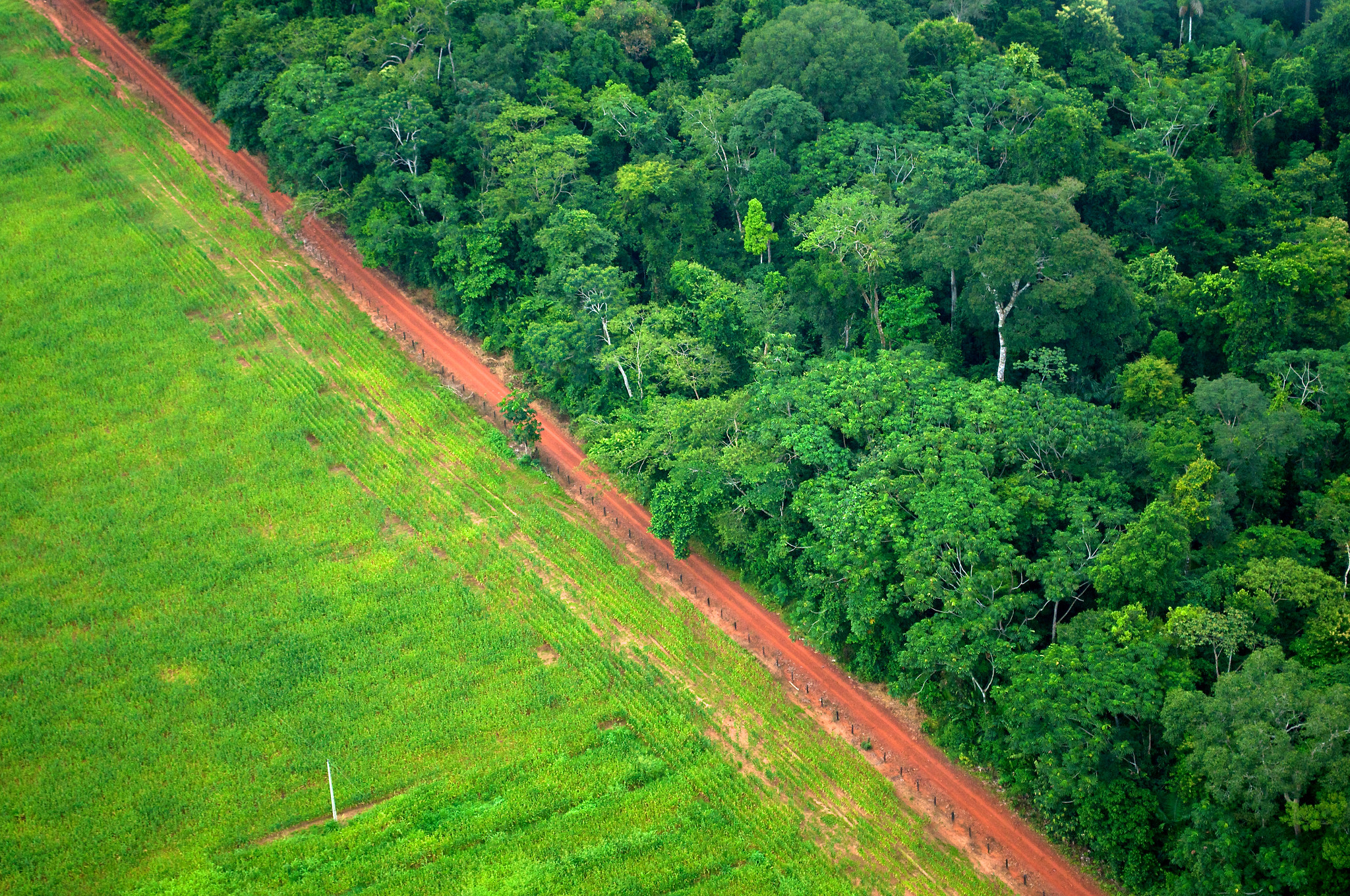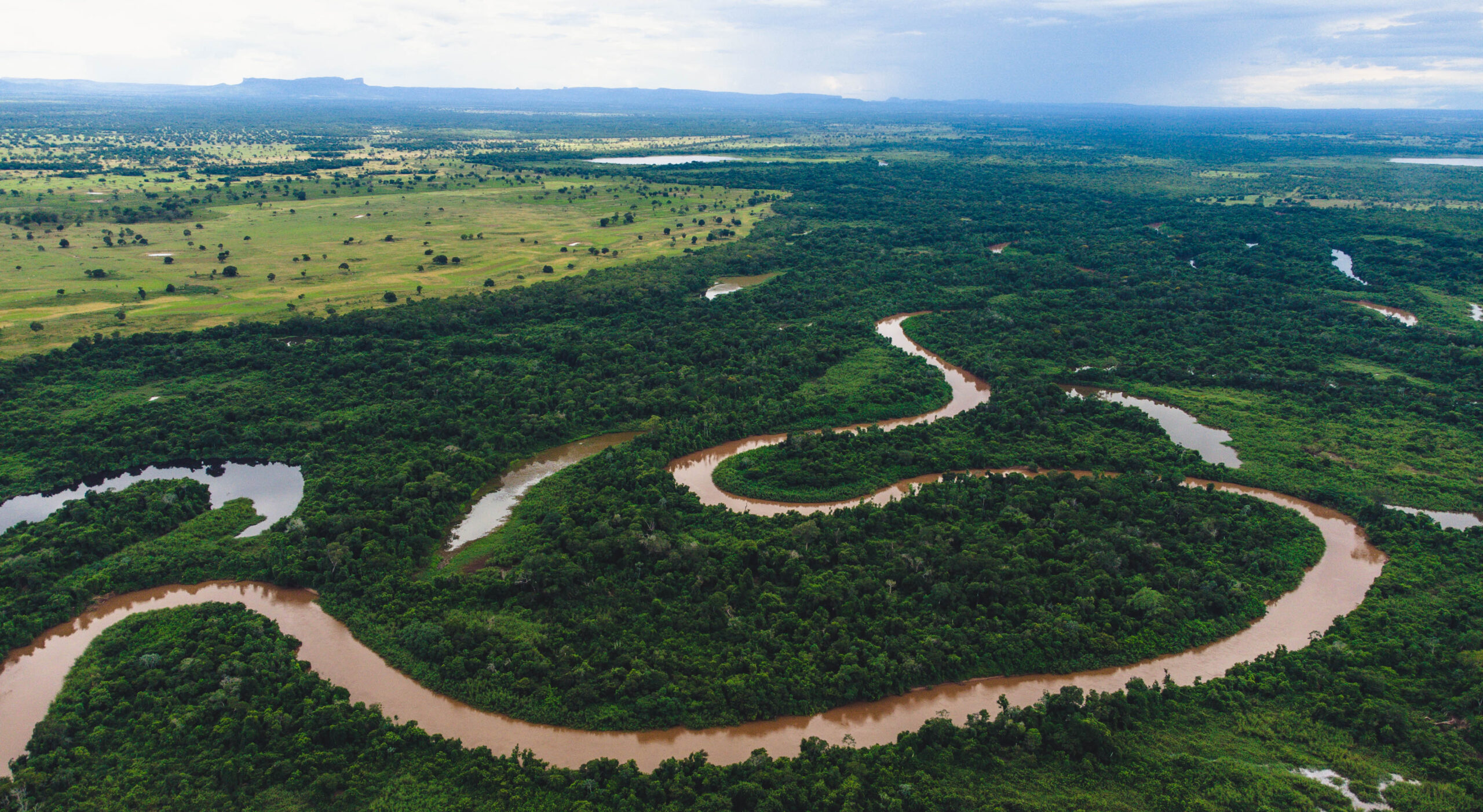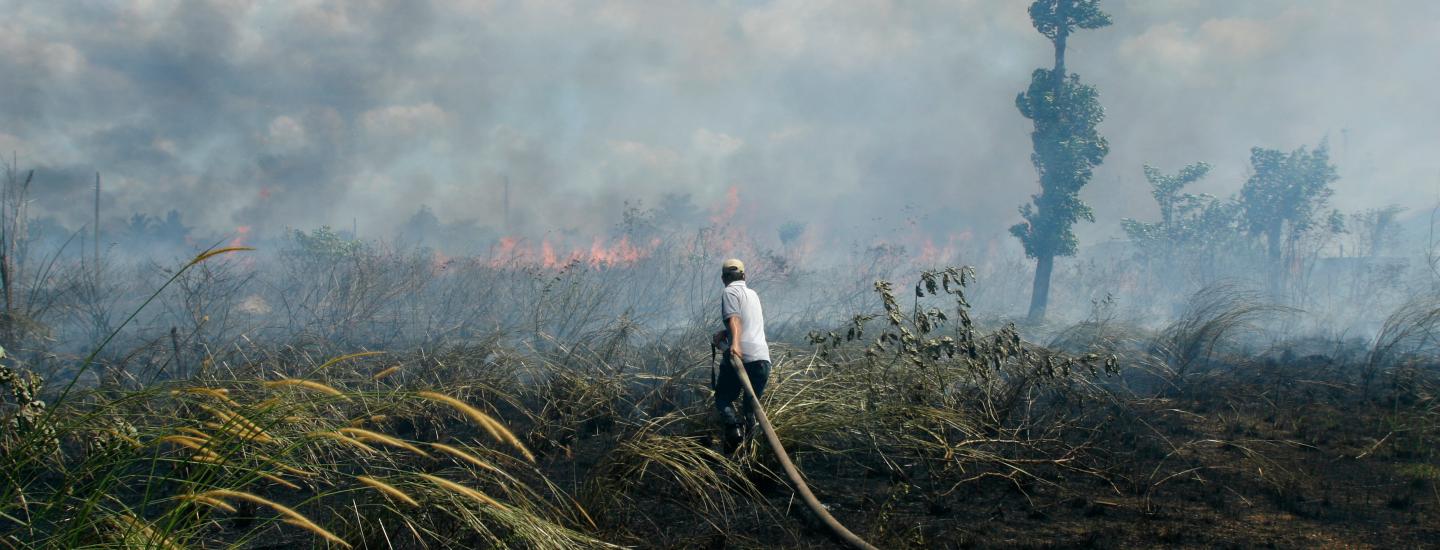- Insights
Tropical Primary Forest Loss Worsened in 2022, Despite International Commitments to End Deforestation

An aerial shot shows the contrast between forest and agricultural landscapes near Rio Branco, Acre, Brazil.
-Kate Evans/CIFOR
The tropics lost 10% more primary rainforest in 2022 than in 2021, according to new data from the University of Maryland and available on WRI’s Global Forest Watch platform.
Tropical primary forest loss in 2022 totaled 4.1 million hectares, the equivalent of losing 11 football (soccer) fields of forest per minute. All this forest loss produced 2.7 gigatonnes (Gt) of carbon dioxide emissions, equivalent to India’s annual fossil fuel emissions.
Tropical primary forest loss, 2002-2022
This increased forest loss comes in the first year after heads of 145 countries vowed in the Glasgow Leaders’ Declaration on Forests and Land Use to halt and reverse forest loss by the end of the decade, recognizing the important role of forests in combating climate change and biodiversity loss. Instead of consistent declines in primary forest loss to meet that goal, the trend is moving in the wrong direction.
Indeed, humanity is not on track to meet major forest-related commitments. Read more in our Targets Tracker.
At the national level, while primary forest loss ticked up in the two countries with the most tropical forest, Brazil and the Democratic Republic of the Congo, it rapidly increased in other nations like Ghana and Bolivia. Meanwhile, Indonesia and Malaysia have managed to keep rates of primary forest loss near record-low levels.
Top countries for primary forest loss
Here’s a deeper look at some of the trends in forest loss in 2022:
Brazilian Amazon sees highest rate of non-fire-related loss since 2005
In Brazil, the rate of primary forest loss increased by 15% from 2021 to 2022, with the vast majority of primary forest loss happening in the Amazon. Non-fire-related losses, which in the Brazilian Amazon are most often due to clear-cut deforestation, reached the highest level since 2005. Read more about how this data compares with Brazil’s official data on deforestation.
This high rate of primary forest loss occurred during the last year of Brazil President Jair Bolsonaro’s administration. Forest loss in Brazil decreased dramatically in the early 2000s under President Luiz Inácio Lula da Silva (Lula), but recent increases have coincided with the Bolsonaro administration’s eroding of environmental protections, gutting of enforcement agencies, attempted granting of amnesty for illegal deforestation and attempted weakening of Indigenous rights.
The re-election of President Lula, sworn in on January 1, 2023, may reverse that trend. He and his administration have promised to end deforestation in the Amazon and other biomes in Brazil by 2030, combining command and control actions with a more long-term perspective around sustainable economic development. This will not be an easy task, with some officials cautioning that there may not be visible progress until 2024 at the earliest as enforcement agencies are re-equipped and re-staffed and illegal activities investigated.
Brazil primary forest loss, 2002-2022
Brazil remains the country with the most tropical primary forest loss by far — in 2022 it accounted for 43% of the global total. Its 1.8 million hectares of primary forest loss resulted in 1.2 Gt of carbon dioxide emissions, or 2.5 times Brazil’s annual fossil fuel emissions. In addition to carbon impacts, forest loss in the Amazon impacts regional rainfall and may eventually lead to a “tipping point” beyond which the majority of the ecosystem will become a savanna.
Within Brazil, primary forest loss accelerated in the Western Amazon. The states of Amazonas and Acre saw some of their highest levels of primary forest loss on record in 2022. Amazonas state, home to over half of Brazil’s intact forests, has nearly doubled its rate of primary forest loss in just three years. Primary forest losses in this part of the Brazilian Amazon are mainly large-scale clearings — likely for cattle pastures — along existing highways.
Primary forest loss in Amazonas, Brazil, 2002-2022
A number of threatened Indigenous territories in the Brazilian Amazon also lost primary forest in 2022. The Apyterewa, Karipuna and Sepoti territories all experienced record levels of primary forest loss related to land invasions. Primary forest loss due to mining is also visible in the Yanomami Indigenous territory, which was subject of a government operation to drive out illegal miners earlier in 2023. Despite these losses, Indigenous territories in Brazil have a much lower deforestation rate than similar lands managed by other actors, and represent the Amazon’s last carbon sinks.
Deforestation expands in the Sepoti Indigenous Territory
Rate of primary forest loss in the Democratic Republic of the Congo remains persistently high
High rates of primary forest loss continued in the Democratic Republic of the Congo (DRC). The country lost over half a million hectares in 2022 and the rate of loss has continued to increase slightly in recent years. Most of the primary forest loss consists of small clearings near cyclical agricultural areas (land that is cleared and burned for the short-term cultivation of crops and left fallow for forests and soil nutrients to regenerate). DRC’s growing population is increasing demand for food, leading to shorter fallow periods and the expansion of agriculture into primary forest.
In other Congo Basin countries, the data showing primary forest loss tends to fluctuate from year to year, likely due to difficulties in satellite data detection from cloud cover. However, Gabon and Republic of Congo — High Forest Low Deforestation (HFLD) countries — continue to experience low overall rates of primary forest loss.
Primary forest loss in the DRC and the Congo Basin, 2015-2022
Reducing primary forest loss in the region remains a challenge. The drivers of loss across Congo Basin countries are predominantly small-scale agriculture and charcoal production, the dominant form of energy in the region, which is generated by cutting and burning timber. In DRC, poverty is widespread and access to electricity is limited — about 62% of the population lives on approximately $2 a day and 81% does not have access to electricity — with local populations relying on forests for food and energy demands.
Investments to lift people out of poverty and reduce reliance on a resource-based economy are urgently needed. A recent $500 million agreement signed at COP26 to protect DRC’s forests shows promise, but has yet to have an impact on deforestation rates. Despite committing to uphold the conservation objectives of protected areas, the DRC government recently auctioned off permits for oil and gas exploration in pristine forest and carbon rich peatlands and indicated that it would soon lift its moratorium on new logging concessions.
Primary forest loss in Ghana at record high
Ghana experienced the largest percent increase in primary forest loss in recent years. In 2022, the country lost 18,000 ha, and while the area of primary forest loss is relatively small, Ghana has little primary forest remaining and experienced the highest proportion of loss of any tropical country in 2022.
The majority of loss occurred within protected areas, which cover the last patches of primary forest in the country. Some of the loss is adjacent to cocoa farms and has a pattern of small-scale clearings likely associated with cocoa production. Other patches of loss appear to be linked to fire and gold mining.
The increase in primary forest loss points to a need to double-down on commitments and efforts underway to tackle loss in the country, including the Cocoa & Forests Initiative which was formed by the governments of Ghana and Côte d’Ivoire and the world’s leading cocoa and chocolate companies to end deforestation and restore forest areas. The European Union (EU), which imports 56% of cocoa beans worldwide, recently passed a regulation that will prohibit the sale of cocoa, timber and other commodities linked to deforestation. The EU and other donors should work with Ghana to empower smallholder farmers to supply deforestation-free products in a manner that safeguards their livelihoods while avoiding deforestation linked to these commodities and lowering primary forest loss in the country.
Primary forest loss is accelerating rapidly in Bolivia
Bolivia saw a record-high level of primary forest loss in 2022, with a 32% increase from 2021 levels. For the third year running, Bolivia was third behind only Brazil and the Democratic Republic of the Congo in area of primary forest loss, surpassing Indonesia despite having less than half the amount of primary forest.
Despite the massive loss of primary forests in recent years, Bolivia has received significantly less attention for deforestation than other rainforest countries. It is also one of the few countries that did not sign on to the Glasgow Leader’s Declaration in 2021.
Commodity agriculture is the main driver of forest loss in Bolivia, particularly in the department of Santa Cruz which has remained a hotspot for loss of primary forests. Soybean expansion has resulted in nearly a million hectares of deforestation in Bolivia since the turn of the century, of which nearly a quarter can be attributed to Mennonite colonies. Though Bolivia has much less soybean production than neighboring countries, most of its expansion has come at the expense of forests. Sugarcane, corn, sorghum and cattle ranching also contribute to deforestation in the country.
Bolivia’s government supports an increase in agribusiness, with goals to reduce imports, implement biofuel production and increase cattle production. These goals have been accompanied by a decriminalization of illegal deforestation and an increase in deforestation authorizations.
Fires have also had a significant impact on Bolivia’s forests in recent years: in 2022, they were responsible for around a third of total primary forest loss in the country. Forest fires in tropical nations like Bolivia are usually set by humans for agricultural purposes, such as regenerating grasslands for grazing and clearing for cropland, or to claim land. In 2022, several fires also appear to have started in areas of selective logging. Fires in Bolivia spread due to drought conditions, which may be linked to the effects of deforestation on rainfall in the Amazon. Several protected areas were also affected by the blazes in 2022, including Noel Kempff Mercado National Park, a biodiversity hotspot and one of Bolivia’s largest parks. The fires have stretched the efforts of firefighters, who have also been hampered by lack of resources and the inaccessibility of some of the fires.
Bolivia primary forest loss, 2002-2022
Primary forest loss in Indonesia remains at historically low levels
Indonesia has reduced its primary forest loss more than any other country in recent years.
As the chart below shows, there is a continued downward trend in Indonesia’s moving average rate.
Indonesia primary forest loss, 2002-2022

Government policies and corrective actions have contributed to this reduction, in line with reaching Indonesia’s target of Net Sink (meaning negative CO2 emissions) from the forestry and other land use sectors by 2030. Increased fire prevention and monitoring efforts, termination of granting new licenses on primary forest and peatland (moratorium), law enforcement, and a renewed commitment not only to protect and restore peatlands but also to rehabilitate mangroves have led to fewer fires and less primary forest loss.
Relatively wet conditions and cloud-seeding efforts from the government and private sector may have helped with the fire suppression in Indonesia. On-the-ground community efforts to suppress fire have also contributed.
Mandatory and voluntary corporate commitments also appear to be working.
Primary forest loss in Malaysia also remains low
In Malaysia, primary forest loss remained low in 2022 and has leveled off in recent years. Corporate and government action also appear to be contributing. No Deforestation, No Peat and No Exploitation (NDPE) commitments now cover the majority of the palm oil sector and in 2018, the Roundtable on Sustainable Palm Oil (RSPO) strengthened its certification requirements. In addition, the Malaysia Sustainable Palm Oil (MSPO) Board was formed in 2015 to certify sustainably grown palm oil. In 2017, the government of Malaysia mandated MSPO certification starting in 2020. Positive government action has continued in more recent years, with a plantation area cap established in 2019 through 2023, and new forestry laws enacted in 2022 to stiffen penalties for illegal logging.
Malaysia primary forest loss, 2002-2022
What happened to forests outside of the tropics?
Total global tree cover loss, which includes loss of primary, secondary and planted forests, declined by 10% in 2022. The decrease is a direct result of a decrease in fire-related losses — non-fire losses increased slightly in 2022, by less than 1%.
Unlike in much of the tropics, fires in boreal and temperate forests are a natural and important part of the ecology. However, the rate of fire-related loss worldwide has generally increased since 2000, likely driven by climate change and human activities, and 2021 saw a major increase in fire-related loss in the boreal region. 2022 was a relatively quieter year for fires globally with a 28% decrease in fire-related loss from 2021, though some areas still experienced significant fire-related loss.
Russia was the biggest contributor to the decline in tree cover loss, with a 34% decrease between 2021 and 2022. Russia had its highest rate of tree cover loss ever in 2021 due to a record-breaking fire season while the 2022 season was below average. Forestry is the other main driver of tree cover loss in Russia, with several instances of expansion into intact forests in 2022. Boreal forests, and Russia in particular, have an outsized impact on the global statistics. Even with the decrease in tree cover loss from 2021 to 2022, Russia still contributed to almost 19% of the global total.
Russia tree cover loss, 2002-2022
Despite the lower area of fire-related loss worldwide in 2022, fires still drove loss in western Europe, which saw major forest fires and resulted in record-breaking tree cover loss in Spain.
Commitments alone won’t stop forest loss
While recent years have seen new international ambition and the recognition of the urgent need to end deforestation, the lack of progress in slowing forest loss in the tropics underscores the need to move beyond political commitments to action. While some countries have shown promising results to reduce forest loss, such as Indonesia and Malaysia, others have seen continued activities and policies that are causing acceleration of deforestation in critical areas.
Protecting forests remains one of the most effective ways to mitigate global climate change and protect the people and biodiversity that depend on them — but time is running out.
Read more about the pathways to end tropical deforestation.
We would like to acknowledge Svetlana Turubanova and Peter Potapov from the University of Maryland, who updated the tree cover loss data, and Sasha Tyukavina from the University of Maryland, who updated the tree cover loss due to fire data.


